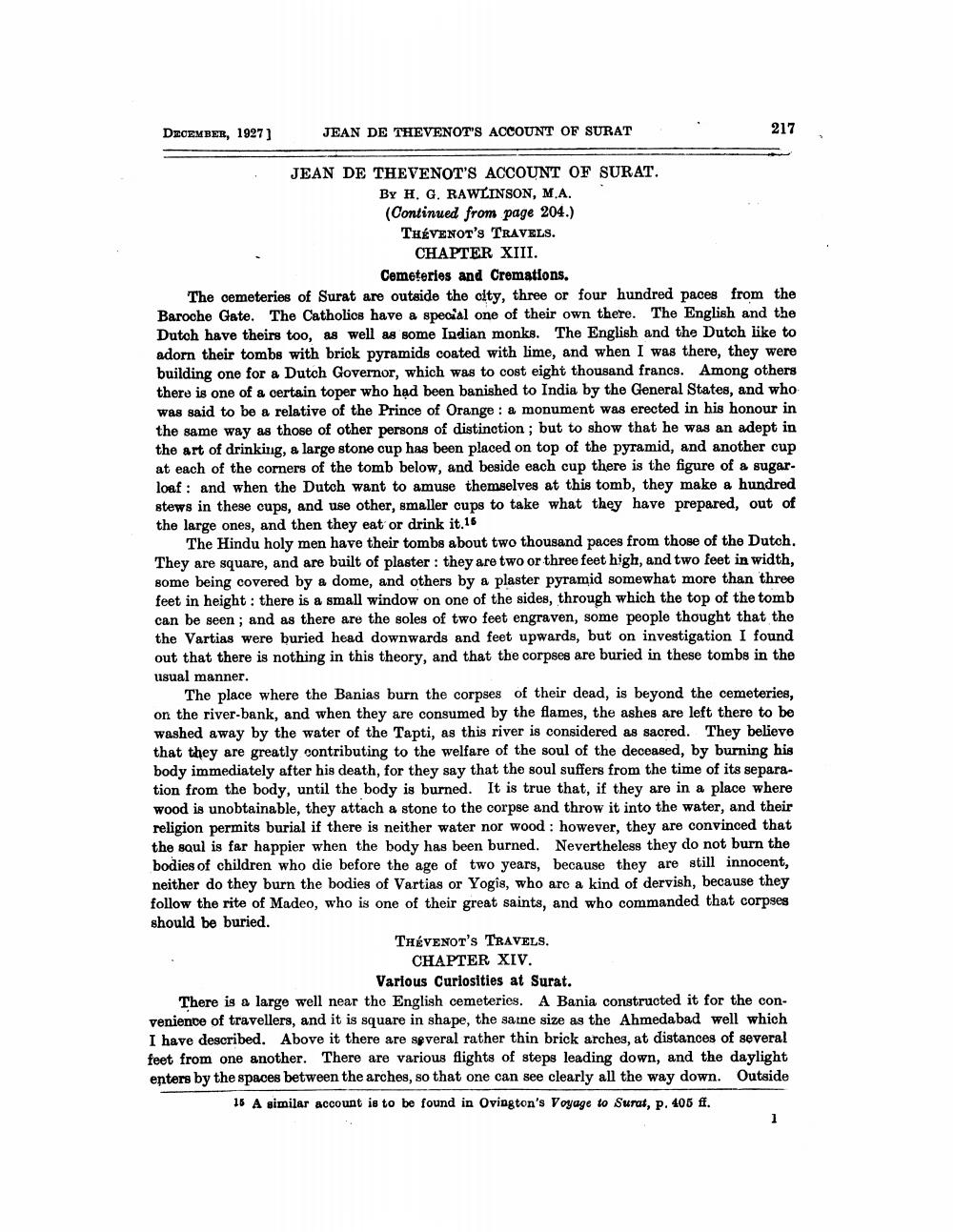________________
DECEMBER, 1927)
JEAN DE THEVENOT'S ACCOUNT OF SURAT
217
JEAN DE THEVENOT'S ACCOUNT OF SURAT.
BY H. G. RAWLINSON, M.A. (Continued from page 204.) THÉVENOT'S TRAVELS.
CHAPTER XIII.
Cemeteries and Cremations. The cemeteries of Surat are outside the city, three or four hundred paces from the Baroche Gate. The Catholics have a special one of their own there. The English and the Dutch have theirs too, as well as some Indian monks. The English and the Dutch like to adorn their tombs with brick pyramids coated with lime, and when I was there, they were building one for a Dutch Governor, which was to cost eight thousand francs. Among others there is one of a certain toper who had been banished to India by the General States, and who was said to be a relative of the Prince of Orange : a monument was erected in his honour in the same way as those of other persons of distinction ; but to show that he was an adept in the art of drinking, a large stone cup has been placed on top of the pyramid, and another cup at each of the corners of the tomb below, and beside each cup there is the figure of a sugar. loaf: and when the Dutch want to amuse themselves at this tomb, they make a hundred stews in these cups, and use other, smaller cups to take what they have prepared, out of the large ones, and then they eat or drink it.16
The Hindu holy men have their tombs about two thousand paces from those of the Dutch, They are square, and are built of plaster : they are two or three feet high, and two feet in width, some being covered by a dome, and others by a plaster pyramid somewhat more than three feet in height : there is a small window on one of the sides, through which the top of the tomb can be seen, and as there are the soles of two feet engraven, some people thought that the the Vartias were buried head downwards and feet upwards, but on investigation I found out that there is nothing in this theory, and that the corpses are buried in these tombs in the usual manner.
The place where the Banias burn the corpses of their dead, is beyond the cemeteries, on the river-bank, and when they are consumed by the flames, the ashes are left there to be washed away by the water of the Tapti, as this river is considered as sacred. They believe that they are greatly contributing to the welfare of the soul of the deceased, by burning his body immediately after his death, for they say that the soul suffers from the time of its separation from the body, until the body is burned. It is true that, if they are in a place where wood is unobtainable, they attach a stone to the corpse and throw it into the water, and their religion permits burial if there is neither water nor wood : however, they are convinced that the soul is far happier when the body has been burned. Nevertheless they do not burn the bodies of children who die before the age of two years, because they are still innocent, neither do they burn the bodies of Vartias or Yogis, who are a kind of dervish, because they follow the rite of Madeo, who is one of their great saints, and who commanded that corpses should be buried.
THÉVENOT'S TRAVELS.
CHAPTER XIV.
Various Curiosities at Surat. There is a large well near the English cemeteries. A Bania constructed it for the convenience of travellers, and it is square in shape, the same size as the Ahmedabad well which I have described. Above it there are several rather thin brick arches, at distances of several feet from one another. There are various flights of steps leading down, and the daylight enters by the spaces between the arches, so that one can see clearly all the way down. Outside
16 A similar account is to be found in Ovington's Voyage to Surat, p. 406 ff.




